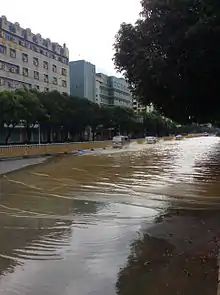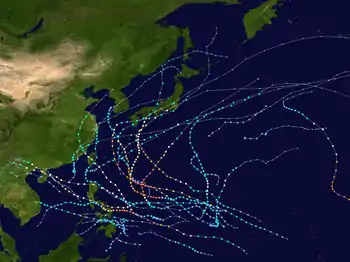Typhoon Matmo (2014)
Typhoon Matmo, known in the Philippines as Typhoon Henry, was the first tropical cyclone to impact Taiwan in 2014. It was the tenth named storm and the fourth typhoon of the 2014 Pacific typhoon season. The typhoon is believed to be one of the main reasons behind the crash of TransAsia Airways Flight 222, which occurred a day after it made landfall. There were fifty-four passengers on board (four of whom were reported to be children) and a crew of four, of whom 48 were killed.[1][2] Taiwan News reported that "first suspicions hinted" the accident might be related to Matmo.[3] The typhoon developed from a cluster of thundershowers consolidating around an area of low pressure in the doldrums. It initially followed a westward track, then made a sharp northwest turn before making landfall on Taiwan, and then China. After moving further inland, Matmo slowly curved back northeastwards and became extratropical before its remnants affected the Korean Peninsula. The typhoon caused damage of US$418 million and there were 65 deaths related to the storm. Matmo brought tropical storm force winds and heavy rainfall to the Philippines, typhoon force winds and torrential rainfall to China and Taiwan and heavy rains to Korea. Two deaths in the Philippines were attributed to the typhoon. The storm left 31,505 people in Taiwan without power. 50 miles per hour (80 km/h) gusts were reported in the Gimpo International Airport of Seoul.[4]
| Typhoon (JMA scale) | |
|---|---|
| Category 2 typhoon (SSHWS) | |
 Typhoon Matmo approaching Taiwan at peak intensity on July 22 | |
| Formed | July 16, 2014 |
| Dissipated | July 26, 2014 |
| (Extratropical after July 25) | |
| Highest winds | 10-minute sustained: 130 km/h (80 mph) 1-minute sustained: 165 km/h (105 mph) |
| Lowest pressure | 965 hPa (mbar); 28.5 inHg |
| Fatalities | 65 total |
| Damage | $418 million (2014 USD) |
| Areas affected | |
| Part of the 2014 Pacific typhoon season | |
Meteorological history

The origins of Matmo can be tracked back to an area of low pressure that developed in the Intertropical Convergence Zone, about 280 km (170 mi) east of Chuuk on July 9, 2014.[5] Over the next few days, the system's low-level circulation center (LLCC) slowly consolidated with convective banding developing around its southern periphery and a burst of convection over its center.[6] Located in a favorable region, the system slowly intensified, prompting the Joint Typhoon Warning Center (JTWC) to issue a Tropical Cyclone Formation Alert (TCFA) on the system, on July 16.[7] Around the same time, the Regional Specialized Meteorological Center in Tokyo, operated by the Japan Meteorological Agency (JMA) started tracking the system as a tropical depression.[8] Tracking slowly northwestward, the depression continued to consolidate while the JTWC initiated advisories on it with the identifier 10W.[9] During the evening of July 17, the JMA upgraded the system to a tropical storm, and assigned it the name Matmo.[10] The subsequent six hours saw the JTWC recognizing Matmo as a tropical storm and the Philippine Atmospheric, Geophysical and Astronomical Services Administration (PAGASA) naming it Henry as it entered the Philippine area of responsibility.[11][12] Matmo accelerated somewhat on July 18 as it passed 450 km (280 mi) north-northwest of Koror, Palau.[13] Around that time, the JMA upgraded Matmo to a severe tropical storm.[14]
By July 19, the center of Matmo had become obscured as deep central convection developed over it. Microwave satellite imagery showed improving convective banding despite the overall structure of the storm being slightly elongated.[15] Subsequent intensification resulted in the JMA upgrading Matmo to a typhoon.[16] The convective banding around the LLCC started to curl inwards as an eye-like feature started developing.[17] Increasing wind shear stemming from the subtropical ridge steering the typhoon inhibited further organization. By July 21, the shear abated somewhat and allowed for some intensification.[18] Tracking well to the southwest of Okinawa, the typhoon increased in both size and organization,[19] with a secondary convective rainband developing along the northern half of the system by July 22. Upper-level outflow also improved and fueled the expansion of convection.[20] A broad eye feature developed with strong convective rainbands wrapped tightly into it.[21] The storm reached peak intensity on July 22, with maximum sustained winds of 140 km/h (85 mph) and a central barometric pressure of 960 mbar (hPa; 28.35 inHg).[22] Around the same time the JTWC estimated Matmo to have acquired one-minute sustained winds of 155 km/h (100 mph), ranking the system as a Category 2-equivalent on the Saffir–Simpson hurricane wind scale.[23] The storm continued on its northwesterly track and made landfall in Taiwan, south of Hualien. The strongest gusts of 212 km/h (132 mph) were recorded on Orchid Island.[24]
Emerging over the Taiwan Strait early on July 23, Matmo was greatly weakened by its passage over Taiwan. Convective rainbands diminished significantly and its circulation became severely disrupted by Taiwan's rugged terrain.[25] The JMA downgraded Matmo into a severe tropical storm and eventually a tropical storm during this process.[26][27] The JTWC, however, maintained Matmo as a typhoon during this time. The storm made its second landfall on China, south of Putian, while parts of its rainbands were still over Taiwan and the Philippines. Once onshore, the JTWC downgraded Matmo to a tropical storm and issued their final advisory.[28] The JMA, however, continued tracking Matmo as a tropical storm until it became extratropical on July 25.[29]
Preparations and impact

The remnants of Matmo brought generally light to moderate rains across South Korea, with Seoul reporting 13 mm (0.5 in). Similar rains were expected over Hokkaido, Japan, with forecasts showing 25 to 51 mm (1 to 2 in) over the island.[30]
Taiwan
About 5,400 tourists evacuated from two islands of Taiwan.[31] Taiwan's military had gathered and distributed sandbags in anticipation of flooding.[32]
The storm made landfall over Taiwan at peak intensity early on July 23. One person was reported dead and some damages were reported,[33] and another 5 were injured, due to the storm.[31] A tourist was also reported missing after taking pictures on a shore.[32] Agricultural losses throughout Taiwan amounted to at least NT$594.9 million (US$20 million). Hualien County sustained the greatest damage, accounting for half the losses.[34]
China
In China, an Orange Tropical Cyclone Alert in areas near Fuzhou.[35][36] Throughout the country, 16 people were killed and economic losses amounted to ¥2.47 billion (US$398 million).[37]
Throughout Fujian Province, 182 EMU trains suffered outages.[38]
See also
References
- "48 confirmed dead, 10 injured in TransAsia plane crash". Focus Taiwan. Retrieved 24 July 2014.
- "Taiwan plane crash – latest". The Daily Telegraph. 23 July 2014. Archived from the original on July 23, 2014. Retrieved 23 July 2014.CS1 maint: unfit URL (link)
- "47 dead, 11 injured in Penghu plane crash: reports". Taiwan News. 23 July 2014. Retrieved 23 July 2014.
- "Typhoon Matmo Recap: Taiwan, East China Hit by Season's Ninth Named Storm". The Weather Channel. Retrieved 15 November 2014.
- "ABPW10 on 2014-07-09". US Naval Observatory. Archived from the original on July 9, 2014. Retrieved 15 November 2014.CS1 maint: unfit URL (link)
- "ABPW10 on 2014-07-16". US Naval Observatory. Archived from the original on July 16, 2014. Retrieved 15 November 2014.CS1 maint: unfit URL (link)
- "TCFA for Typhoon Matmo". JTWC. Archived from the original on 17 July 2014. Retrieved 15 November 2014.
- "JMA starts tracking MATMO". RSMC Tokyo. Archived from the original on 17 July 2014. Retrieved 15 November 2014.
- "JTWC Tropical Cyclone Warning 01 on Typhoon Matmo". JTWC. Archived from the original on July 18, 2014. Retrieved 15 November 2014.CS1 maint: unfit URL (link)
- "JMA Advisory 171800 on Typhoon Matmo". JMA. Archived from the original on July 18, 2014. Retrieved 15 November 2014.CS1 maint: unfit URL (link)
- "Matmo enters PAR". PAGASA. Archived from the original on 19 July 2014. Retrieved 15 November 2014.
- "JTWC Tropical Cyclone Warning 02 for Typhoon Matmo". JTWC. Archived from the original on July 18, 2014. Retrieved 15 November 2014.CS1 maint: unfit URL (link)
- "Prognostic Reasoning for Warning 06 on Typhoon Matmo". JTWC. Archived from the original on July 19, 2014. Retrieved 15 November 2014.CS1 maint: unfit URL (link)
- "STS Matmo - JMA". RSMC Tokyo. Archived from the original on July 19, 2014. Retrieved 15 November 2014.CS1 maint: unfit URL (link)
- "Prognostic Reasoning for Warning 08 on Typhoon Matmo". JTWC. Archived from the original on July 20, 2014. Retrieved 15 November 2014.CS1 maint: unfit URL (link)
- "TY Matmo from RSMC Tokyo". RSMC Tokyo. Archived from the original on July 20, 2014. Retrieved 15 November 2014.CS1 maint: unfit URL (link)
- "Prognostic Reasoning for Warning 10 on Typhoon Matmo". JTWC. Archived from the original on July 20, 2014. Retrieved 15 November 2014.CS1 maint: unfit URL (link)
- "Prognostic Reasoning for Warning 15 on Typhoon Matmo". JTWC. Archived from the original on July 21, 2014. Retrieved 15 November 2014.CS1 maint: unfit URL (link)
- "Prognostic Reasoning for Warning 17 on Typhoon Matmo". JTWC. Archived from the original on July 22, 2014. Retrieved 15 November 2014.CS1 maint: unfit URL (link)
- "Prognostic Reasoning for Warning 19 on Typhoon Matmo". JTWC. Archived from the original on July 22, 2014. Retrieved 15 November 2014.CS1 maint: unfit URL (link)
- "Prognostic Reasoning for Warning 21 on Typhoon Matmo". JTWC. Archived from the original on July 23, 2014. Retrieved 15 November 2014.CS1 maint: unfit URL (link)
- "Peak Intensity from JMA". JMA. Archived from the original on July 22, 2014. Retrieved 15 November 2014.CS1 maint: unfit URL (link)
- "Peak Intensity from JTWC". JTWC. Archived from the original on July 23, 2014. Retrieved 15 November 2014.CS1 maint: unfit URL (link)
- "Typhoon Matmo made landfall in Taiwan, tracking toward southeastern China". The Watchers. Retrieved 15 November 2014.
- "Prognostic Reasoning for Warning 23 on Typhoon Matmo". JTWC. Archived from the original on July 23, 2014. Retrieved 15 November 2014.CS1 maint: unfit URL (link)
- "JMA Downgrades Matmo to STS". JMA. Archived from the original on July 23, 2014. Retrieved 15 November 2014.CS1 maint: unfit URL (link)
- "JMA Downgrades Matmo to a Tropical Storm". JMA. Archived from the original on July 23, 2014. Retrieved 15 November 2014.CS1 maint: unfit URL (link)
- "JTWC Final Warning on Matmo". JTWC. Archived from the original on July 24, 2014. Retrieved 15 November 2014.CS1 maint: unfit URL (link)
- "Matmo becomes extra-tropical". JMA. Archived from the original on July 25, 2014. Retrieved 15 November 2014.CS1 maint: unfit URL (link)
- "Tropical Rainstorm Matmo to Impact Japan". AccuWeather. July 26, 2014. Archived from the original on August 8, 2014. Retrieved July 27, 2014.
- "Typhoon Matmo batters Taiwan, five hurt". Retrieved July 23, 2014.
- "Typhoon Matmo heads for mainland China after battering Taiwan with 155km/h winds". Retrieved July 22, 2014.
- "Typhoon Matmo slams into Taiwan, one killed". Retrieved July 23, 2014.
- "Agricultural losses from Typhoon Matmo reach nearly US$20 million". Taiwan News. July 28, 2014. Retrieved July 28, 2014.
- "Orange Tropical Cyclone alert for MATMO-14 in China".
- "Severe Tropical Storm Matmo, TD #2, severe thunderstorms".
- "Member Report: China" (PDF). CMA. China Meterelogical Agency. Retrieved October 18, 2014.
- 台风“麦德姆”登陆福建182列动车停运. Reuters (in Chinese). Epoch Times. July 23, 2014. Retrieved December 18, 2014.
External links
| Wikimedia Commons has media related to Typhoon Matmo (2014). |
- JMA General Information of Typhoon Matmo (1410) from Digital Typhoon
- JMA Best Track Data of Typhoon Matmo (1410) (in Japanese)
- JMA Best Track Data (Graphics) of Typhoon Matmo (1410)
- JMA Best Track Data (Text)
- 10W.MATMO from the U.S. Naval Research Laboratory
